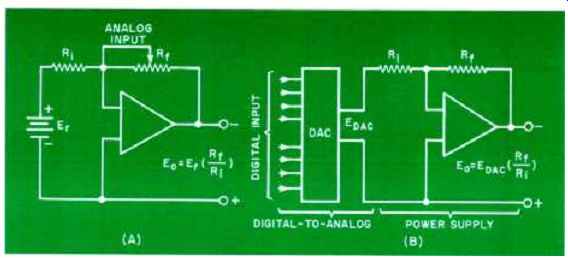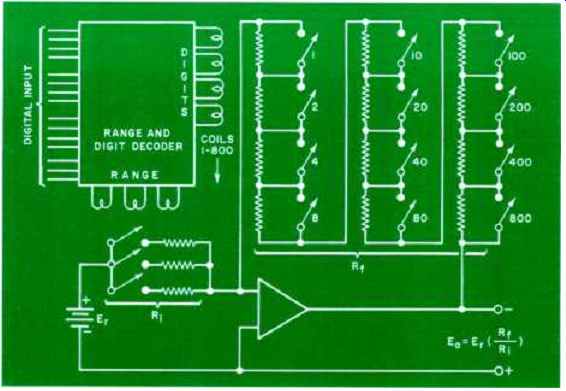by PAUL BIRMAN, Manager, Applications Engineering, Kepco, Inc.
There are many occasions when you must use a power supply which is "smart enough" to understand digital instructions. Here's how it is done.

--- A digitally programmed system that will function with any
operational power supply to produce a digitally controlled output
of 0-1000 V. Units (left) the DPR- 5- 5%digit readout; (right) the
DPD-1 digital programming decade; and (front) the DPK-1 digital programming
keyboard are by Kepco, Inc.
A digitally programmed system that will function with any operational power supply to produce a digitally controlled output of 0-1000 V. Units (left) the DPR- 5- 5%digit readout; (right) the DPD-1 digital programming decade; and (front) the DPK-1 digital programming keyboard are by Kepco, Inc.
POWER supplies belong securely to the world of analog things, a world where electrical quantities flow smoothly in a (hopefully) infinite continuum. Your bench supply is like that; its output is probably adjusted by a knob whose possible settings, or resolution, is limited primarily by the steadiness of your hand. It is also limited by the quality of the control used to make the adjustment.
In the digital world of computers, bits and pulses, and such, resolution is not so haphazardly determined. A given quantity is composed of just so many "bits of information" and the resolution of the thing is set by the number of bits used.
When power supplies are used in automatic systems, the knob-method of control (Fig. 1A)--so handy on the bench--gives way to a more machine--compatible way of control, in other words--programming.
It is a fact of life that most machine controls today employ digital language to communicate instructions to the various elements of an equipment system. To fit into such systems, then, it is necessary to teach the basically analog power supply how to understand digital language.
There are units available which can perform a digital-to-analog conversion (called DAC's). Placed between the incoming digital instruction and a programmable power supply, they will provide the needed interface (Fig. 1B). Alternatively, you can feed the digital signals into decoding circuits which operate directly into a power supply's reference and feedback control circuits.
You can't do these things to an ordinary power supply, of course. It must be one "smart enough" to understand digital instructions--it must be a power supply with sufficient suppression of spurious responses that it only answers to legitimate digital signals. It must be the kind of supply known as "operational," because its response can be mathematically figured from the relationship of "operators" or controls (Figs. 1A and 1B). An operational power supply, like an operational amplifier, responds linearly to the combination of input and feedback conditions to produce an accurate output reproduction of its instructions. If the instructions are to remain fixed at a specific voltage, the operational power supply becomes a constant-voltage stabilizer. If the instructions say remain fixed at a certain current, it is called a current stabilizer. If the instructions call for the output to be varied in accordance with this pre-planned program, the operational power supply can do that too.
A critical characteristic of the operational power supply is its ability to "go to zero" when commanded to do so-or in the absence of any contrary instruction, it must not go to -0.1 volt or +0.01 volt; it must be trimmable so that zero is really zero. It this were not so, its response to the digital instruction would always have an error.
A second important characteristic is the power supply's ability to change output quickly. This will govern how far behind the digital instructions the actual output will lag and determine the minimum time between successive instructions.
Assuming you have a "smart" operational power supply and have chosen to use it either as a linear amplifier, reproducing the analog output of the DAC, or are going to decode directly into the supply's control loop (Fig. 2), you now must worry about isolation. If the supply's d.c. output is electrically common to the digital "ground" (and is of the right polarity), there is no problem. More likely, though, there will be a need for electrical isolation so that the d.c. output of the power supply floats relative to the digital lines.
The popular ways of isolating the digital from the analog involve: (a) relay coupling; (b) r.f. coupling; (c) optical coupling; and (d) inductive coupling. In most cases, the isolation is provided at the digital end of the interface because it is easier to put an "on-off' digital bit through the selected coupler than it is to get a linear analog signal through.
Relays, often encapsulated reed-types, are the most widely used method of insuring electrical isolation. The digital signal goes to the relay's coil and comes out, isolated at the contacts, ready for the digital-to-analog conversion. Inductive and r.f. coupling have also been used with success.
Modern semiconductor technology with light-emitting diodes (LED's) has greatly enhanced the attraction of optical coupling, and the newer digital programmers for operational power supplies use this method for their isolation.
In today's highly developed equipment systems, "smart" operational power supplies can be found on-line with their output under digital control responding quickly and accurately to the demands of a high-resolution control computer. Such power supplies may seem remote from the ordinary unit on the bench--but chances are it is quite similar, since the operational technique for controlling output is widely used for most precision equipment.
If it has (or you can add) provision for proper zeroing and it is a "programmable" supply, you might have the basis for a digitally controlled power supply right at hand.
There are a number of digital /analog interfaces available commercially including the Kepco DPD series which are relay-isolated and work directly in any selected operational power supply's feedback loop.
These include: Model DPD-1 (4 1/2 digit, 0- 1000.0 V control), DPD-2 (4 1/2 digit, 0- 100.00 V control), DPD-3 (5 1/2 digit, 0- 1000.00 V control), DPD-4 (3 1/2 digit, 0-1000 V control, DPD-5 (3 1/2 digit, 0-100.0 V control), DPD-6 (3 1/2 digit, 0-10.00 V control, and DPD-7 (3 1/2 digit, current control). These units couple to any operational power supply to form a digitally programmable power-supply system, a bipolar (two-directional) digital system if a bipolar supply is used.
Also available are 3 1/2, 4 1/2, and 5 1/2 digit serial to parallel information-storage and display registers (DPR-3, DPR- 4, and DPR-5) as well as a manual keyboard, Model DPK-1.
The Kepco Model PVS 100-1M is a switch-selected or relay-isolated D/A with built-in 0-100 volt, 0-1 ampere precision voltage source.
The company's SN series are optically isolated digital-to-analog converters which produce analog output which the power supply can amplify linearly.
The SN-2 is a 2-digit BCD, 8-bit binary, parallel storage unit with 0-1 volt output which can be amplified to any desired level. SN-3 is a 3-digit BCD, 12- bit binary, parallel storage type with 0- 10 volt output which can also be amplified to any desired level. These units couple to any operational power supply to form a digitally programmable power supply, unipolar or bipolar.
Hewlett-Packard's Models 6130B, 6131B, r.f.-isolated combination of digital-to-analog converter has parallel storage with built-in bipolar power supply. The 6130B is rated 50-0-+50 volts at 0-1 ampere while the 6131B is rated-100-0H-100 volts at 0.5 ampere.
John Fluke offers a combination of digital-to-analog converter, parallel storage with built-in supply in its Models 4210A (0-10 volts at 0-100 mA), 4216A (0-16 volts at 0-100 mA), and 4250A/4265A (0-65 volts at 0-1 A).

Fig. 1. (A) An operational power supply connected as voltage stabilizer.
R_r is voltage control and adjusts output; and (B) with a DAC driver.

Fig. 2. An operational power supply with the digital operators controlling
both Rf and Ri directly. Refer to article for details on operation.